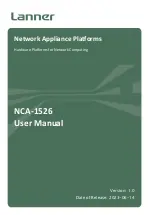
© Copyright IBM Corp. 2011
Chapter 10. Spanning Tree Protocols
117
Port States
The port state controls the forwarding and learning processes of Spanning Tree. In
PVRST, the port state has been consolidated to the following:
discarding
,
learning
, and
forwarding
.
Due to the sequence involved in these STP states, considerable delays may occur
while paths are being resolved. To mitigate delays, ports defined as
edge
ports
“Port Type and Link Type” on page 129
) may bypass the
discarding
and
learning
states, and enter directly into the
forwarding
state.
Bridge Protocol Data Units
Bridge Protocol Data Units Overview
To create a Spanning Tree, the switch generates a configuration Bridge Protocol
Data Unit (BPDU), which it then forwards out of its ports. All switches in the Layer 2
network participating in the Spanning Tree gather information about other switches
in the network through an exchange of BPDUs.
A bridge sends BPDU packets at a configurable regular interval (2 seconds by
default). The BPDU is used to establish a path, much like a hello packet in IP
routing. BPDUs contain information about the transmitting bridge and its ports,
including bridge MAC addresses, bridge priority, port priority, and path cost. If the
ports are tagged, each port sends out a special BPDU containing the tagged
information.
The generic action of a switch on receiving a BPDU is to compare the received
BPDU to its own BPDU that it will transmit. If the received BPDU is better than its
own BPDU, it will replace its BPDU with the received BPDU. Then, the switch adds
its own bridge ID number and increments the path cost of the BPDU. The switch
uses this information to block any necessary ports.
Note:
If STP is globally disabled, BPDUs from external devices will transit the
switch transparently. If STP is globally enabled, for ports where STP is
turned off, inbound BPDUs will instead be discarded.
Determining the Path for Forwarding BPDUs
When determining which port to use for forwarding and which port to block, the
G8000 uses information in the BPDU, including each bridge ID. A technique based
on the “lowest root cost” is then computed to determine the most efficient path for
forwarding.
Bridge Priority
The bridge priority parameter controls which bridge on the network is the STG root
bridge. To make one switch become the root bridge, configure the bridge priority
lower than all other switches and bridges on your network. The lower the value, the
higher the bridge priority. Use the following command to configure the bridge
priority:
RS G8000(config)#
spanning-tree stp
<x>
bridge priority
<0-65535>
Summary of Contents for RackSwitch G8000
Page 1: ...RackSwitch G8000 Application Guide...
Page 2: ......
Page 3: ...RackSwitch G8000 Application Guide...
Page 16: ...16 RackSwitch G8000 Application Guide...
Page 22: ...20 RackSwitch G8000 Application Guide...
Page 23: ...Copyright IBM Corp 2011 21 Part 1 Getting Started...
Page 24: ...22 RackSwitch G8000 Application Guide...
Page 54: ...52 RackSwitch G8000 Application Guide...
Page 55: ...Copyright IBM Corp 2011 53 Part 2 Securing the Switch...
Page 56: ...54 RackSwitch G8000 Application Guide...
Page 92: ...90 RackSwitch G8000 Application Guide...
Page 94: ...92 RackSwitch G8000 Application Guide...
Page 144: ...142 RackSwitch G8000 Application Guide...
Page 145: ...Copyright IBM Corp 2011 143 Part 4 Advanced Switch ing Features...
Page 146: ...144 RackSwitch G8000 Application Guide...
Page 148: ...146 RackSwitch G8000 Application Guide...
Page 182: ...180 RackSwitch G8000 Application Guide...
Page 184: ...182 RackSwitch G8000 Application Guide...
Page 212: ...210 RackSwitch G8000 Application Guide...
Page 258: ...256 RackSwitch G8000 Application Guide...
Page 286: ...284 RackSwitch G8000 Application Guide...
Page 294: ...292 RackSwitch G8000 Application Guide...
Page 298: ...296 RackSwitch G8000 Application Guide...
Page 310: ...308 RackSwitch G8000 Application Guide...
Page 311: ...Copyright IBM Corp 2011 309 Part 7 Network Management...
Page 312: ...310 RackSwitch G8000 Application Guide...
Page 320: ...318 RackSwitch G8000 Application Guide...
Page 332: ...330 RackSwitch G8000 Application Guide...
Page 334: ...332 RackSwitch G8000 Application Guide...
Page 345: ...Copyright IBM Corp 2011 343 Part 9 Appendices...
Page 346: ...344 RackSwitch G8000 Application Guide...
Page 357: ...Copyright IBM Corp 2011 Appendix C Notices 355 Taiwan Class A compliance statement...
















































